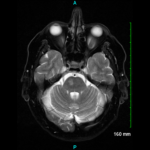 Giant cell arteritis (GCA) causes granulomatous inflammation, primarily in the aortic arch and extracranial portion of the carotid artery. Patients with GCA are at increased risk for adverse events, especially during the first year after diagnosis. Although the cause of GCA is unknown, researchers have shown that patients have activated dendritic cells, T cells and macrophages, which appear to play central roles in the pathogenesis of the disorder.
Giant cell arteritis (GCA) causes granulomatous inflammation, primarily in the aortic arch and extracranial portion of the carotid artery. Patients with GCA are at increased risk for adverse events, especially during the first year after diagnosis. Although the cause of GCA is unknown, researchers have shown that patients have activated dendritic cells, T cells and macrophages, which appear to play central roles in the pathogenesis of the disorder.
New results reveal that the interleukin (IL)-6 receptor alpha inhibitor tocilizumab helps sustain glucocorticoid-free remission in patients with GCA. John H. Stone, MD, MPH, director of Clinical Rheumatology at the Massachusetts General Hospital in Boston, and colleagues compared weekly or bi-weekly treatment with tocilizumab in combination with a 26-week prednisone taper with either a 26-week or 52-week prednisone tapering plus placebo. The results of the one-year trial were published July 27 in The New England Journal of Medicine.1,2.
The researchers randomly assigned 251 patients with active GCA to one of two groups that received different doses of tocilizumab administered subcutaneously in combination with a 26-week prednisone taper (n=150). Patients were also assigned to one of two groups that received placebo and prednisone with the prednisone tapered over 26 weeks (n=50) or 52 weeks (n=51).
Both regimens—weekly and bi-weekly tocilizumab—in combination with a prednisone taper over 26 weeks were superior to placebo plus a prednisone taper of 26 weeks or 52 weeks. Specifically, approximately 50% of the patents treated with tocilizumab achieved prednisone-free remission when compared with approximately 15% of those in the placebo groups.
The investigators also found that only one quarter of patients treated with tocilizumab experienced flares compared with 68% of patients in the placebo group who underwent a 26-week taper and 49% of patients in the placebo group who underwent a 52-week taper. The investigators used this data to calculate a hazard ratio for flare of 0.23 (99% confidence interval [CI], 0.11 to 0.46) in the group that received tocilizumab weekly relative to those who received placebo and had a 26-week taper and 0.28 (99% CI, 0.12 to 0.66) in the group that received tocilizumab bi-weekly relative to those who received placebo and had a 26-week taper (P<0.001 for both comparisons).
Tocilizumab treatment was also associated with a reduction in the cumulative prednisone dose over the 52-week trial period. Specifically, the cumulative median prednisone dose over the 52-week period was 1,862 mg in each tocilizumab group, 3,296 mg in the placebo group that underwent the 26-week taper (P<0.001) and 3,818 in the placebo group that underwent the 52-week taper (P<0.001). Moreover, post hoc analyses revealed that 23% of patients who received tocilizumab weekly received open-label prednisone as escape therapy compared with 33% in the group that received tocilizumab every other week, 74% in the placebo group that underwent the 26-week taper and 55% in the placebo group that underwent the 52-week taper.

